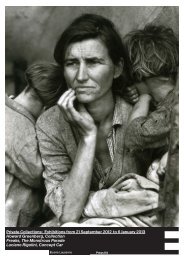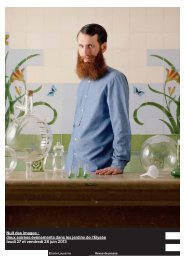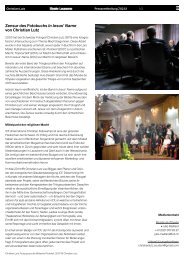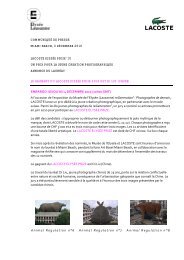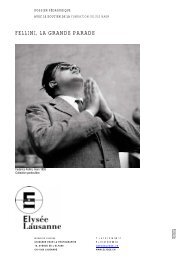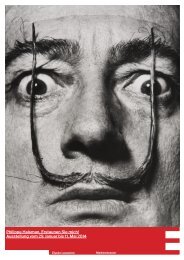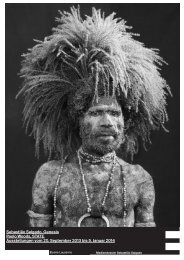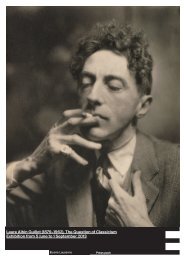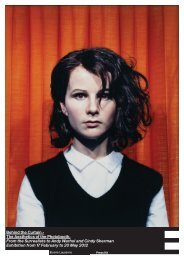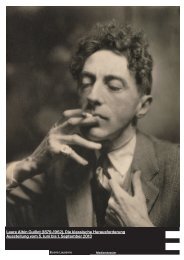Philippe Halsman, Astonish Me! Exhibition from ... - Musée de l'Elysée
Philippe Halsman, Astonish Me! Exhibition from ... - Musée de l'Elysée
Philippe Halsman, Astonish Me! Exhibition from ... - Musée de l'Elysée
Create successful ePaper yourself
Turn your PDF publications into a flip-book with our unique Google optimized e-Paper software.
<strong>Philippe</strong> <strong>Halsman</strong>Elysée LausannePress kit5/13PortraitsChampion of the direct approach, <strong>Philippe</strong> <strong>Halsman</strong> also experimentedwith a wi<strong>de</strong> range of techniques in or<strong>de</strong>r to capture theessence of his subjects and express their individuality. Many portraitsbecame iconic images such as his 101 Life magazine covers.Focus on Marilyn Monroe<strong>Philippe</strong> <strong>Halsman</strong> photographed Marilyn Monroe on severaloccasions between 1949 and 1959. This important corpus tracesthe actress’s career and reveals the photographer’s variedapproach during this period. In the autumn of 1949, <strong>Halsman</strong> wassent to Hollywood by Life magazine to do a report on eight youngmo<strong>de</strong>ls embarking on acting careers. <strong>Halsman</strong> photographed themin four scenes he imposed (the approach of a monster, embrassinga lover, reacting to a funny story and drinking a favorite drink). Hequickly noticed the talents of the young Marilyn Monroe.This opinion was confirmed three years later when Lifecommissioned him to do a feature on the actress entitled “TheTalk of Hollywood”. These shots, some in color and some in blackand white, illustrated the actresses’s everyday life and talents. Sheacted out a series of scenes, humorously presenting the differentstages of the strategy she used when being interviewed for roles.Most importantly, <strong>Halsman</strong> created several emblematic images ofthe actress and helped promote her by giving her a chance to haveher first Life magazine cover.In 1954, <strong>Halsman</strong> welcomed Marilyn Monroe to his New Yorkstudio. <strong>Halsman</strong>’s photographs reflect the 'sex symbol' image shecultivated. However, he managed to shoot a more natural portraitof the actress by asking her to jump in the air. There was only a fewimages of this type because when <strong>Halsman</strong> explained his'jumpology' concept, Marilyn Monroe, frightened by the i<strong>de</strong>a ofrevealing her personality, refused to repeat the experiment.It took five years before she agreed to go along with 'jumpology'.Marilyn Monroe had become a star by the time Life magazineoffered to feature her on its cover in 1959 to illustrate a major articleon <strong>Philippe</strong> <strong>Halsman</strong>’s 'jumpology'. She treated it as a request for aperformance. Over the course of three hours, the actress jumpedover 200 times in front of <strong>Halsman</strong>’s lens, in or<strong>de</strong>r to achieve the“perfect jump”."Of the group of starlets only Marilyn emerged.Still photographers discovered her natural talent forflirting with the camera lens, and her blondlooks of instant availability ma<strong>de</strong> herAmerica’s most popular pin-up girl.Marilyn felt that the lens was not just a glass eye, butthe symbol of the eyes of millions of men.She knew how to woo this lens betterthan any actress I ever photographed."<strong>Philippe</strong> <strong>Halsman</strong>Several times <strong>Halsman</strong> suggested to Marilyn Monroe that theycontinue this collaboration, but without success. The actresswas then at a turning point in her life that was foreshadowing her<strong>de</strong>cline. However, <strong>Halsman</strong> continued his photographic work onthe actress by creating new images, or more precisely variations ofportraits he had previously shot. These compositions -montagesof prints cut out and rephotographed together expressing the i<strong>de</strong>aof movement, or reworked images transposed in negative formarecharacteristic of <strong>Halsman</strong>’s approach in the 1960s. Ten yearslater, he created a portrait of Marilyn Monroe as Chairman Mao,as requested by Salvador Dalí during his guest editorship of theFrench edition of Vogue magazine (December 1971-January 1972).<strong>Philippe</strong> <strong>Halsman</strong>, Contact print of Marilyn Monroe, 1952<strong>Philippe</strong> <strong>Halsman</strong> Archive © 2013 <strong>Philippe</strong> <strong>Halsman</strong> Archive / Magnum Photos



